Turbidity Equipment Market
Turbidity Equipment Market Size and Share Forecast Outlook 2025 to 2035
Turbidity equipment market is projected to grow from USD 960.0 million in 2025 to USD 1,421.0 million by 2035, at a CAGR of 4.0%. Portable will dominate with a 42.0% market share, while water treatment will lead the application segment with a 54.0% share.
Turbidity Equipment Market Forecast and Outlook 2025 to 2035
The global turbidity equipment market is projected to reach USD 1,420 million by 2035, recording an absolute increase of USD 460 million over the forecast period. The market is valued at USD 960 million in 2025 and is set to rise at a CAGR of 4% during the assessment period. The overall market size is expected to grow by nearly 1.5 times during the same period, supported by increasing demand for water quality monitoring systems worldwide, driving demand for precise measurement technologies and increasing investments in water treatment infrastructure and environmental monitoring systems globally. High equipment maintenance costs and complex calibration procedures may pose challenges to market expansion.
Quick Stats for Turbidity Equipment Market
- Turbidity Equipment Market Value (2025): USD 960 million
- Turbidity Equipment Market Forecast Value (2035): USD 1,420 million
- Turbidity Equipment Market Forecast CAGR: 4%
- Leading Equipment Type in Turbidity Equipment Market: Portable Equipment
- Key Growth Regions in Turbidity Equipment Market: North America, Europe, and Asia Pacific
- Top Key Players in Turbidity Equipment Market: Hach (Danaher), Thermo Fisher, Xylem, Hanna Instruments, Lovibond, LaMotte, Merck Millipore, Aqualabo, HF Scientific, KEM
- Turbidity Equipment Market Year-over-Year Forecast (2025-2035)
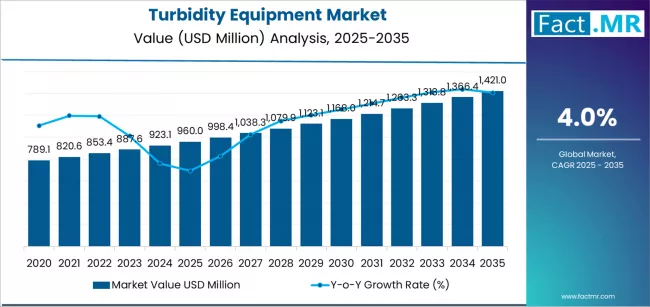
Between 2025 and 2030, the turbidity equipment market is projected to expand from USD 960 million to USD 1,170 million, resulting in a value increase of USD 210 million, which represents 45.7% of the total forecast growth for the decade. This phase of development will be shaped by rising demand for water quality compliance and environmental monitoring solutions, product innovation in sensor technologies and digital interfaces, as well as expanding integration with automated monitoring systems and IoT-enabled platforms. Companies are establishing competitive positions through investment in advanced measurement technologies, portable monitoring solutions, and strategic market expansion across water treatment, food and beverage, and industrial applications.
From 2030 to 2035, the market is forecast to grow from USD 1,170 million to USD 1,420 million, adding another USD 250 million, which constitutes 54.3% of the overall ten-year expansion. This period is expected to be characterized by the expansion of specialized turbidity monitoring systems, including wireless connectivity and cloud-based data management solutions tailored for specific applications, strategic collaborations between equipment manufacturers and water treatment companies, and an enhanced focus on real-time monitoring capabilities and predictive maintenance features. The growing emphasis on water quality assurance and regulatory compliance will drive demand for comprehensive turbidity monitoring solutions across diverse industrial and municipal applications.
Turbidity Equipment Market Key Takeaways
| Metric | Value |
|---|---|
| Market Value (2025) | USD 960 million |
| Market Forecast Value (2035) | USD 1,420 million |
| Forecast CAGR (2025-2035) | 4% |
Why is the Turbidity Equipment Market Growing?
The turbidity equipment market grows by enabling water treatment facilities and laboratories to optimize water quality monitoring while accessing advanced measurement technologies without substantial manual testing requirements. Municipal utilities and industrial facilities face mounting pressure to improve water quality compliance and reduce operational costs, with modern turbidity equipment typically providing 80-90% higher accuracy rates compared to traditional testing alternatives, making intelligent monitoring systems essential for regulatory compliance positioning. The water treatment industry's need for real-time quality monitoring and application-specific contamination detection creates demand for comprehensive turbidity solutions that can provide superior accuracy, maintain consistent performance, and ensure reliable operation without compromising treatment efficiency or compliance standards.
Government regulations promoting water quality standards and environmental monitoring drive adoption in municipal water treatment, industrial processing, and food and beverage applications, where precise turbidity measurement has a direct impact on product quality and regulatory compliance. Equipment complexity constraints during calibration phases and the expertise requirements for turbidity system deployment may limit accessibility among smaller utilities and developing regions with limited technical infrastructure for advanced water monitoring systems.
Segmental Analysis
The market is segmented by equipment type, application, and region. By equipment type, the market is divided into portable, benchtop, and online/continuous monitoring systems. Based on application, the market is categorized into water treatment, food and beverage, and other applications. Regionally, the market is divided in North America, Europe, Asia Pacific, and other key regions.
By Equipment Type, the Portable Segment Accounts for a Dominant Market Share
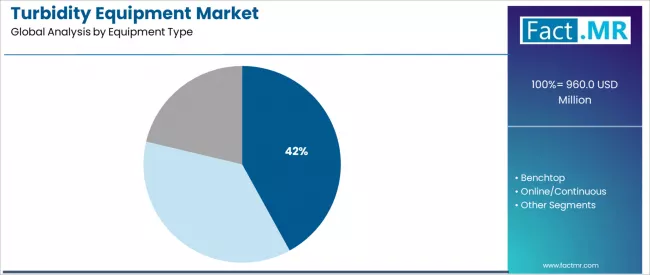
The portable turbidity equipment segment represents the dominant force in the turbidity equipment market, capturing approximately 42% of total market share in 2025. This established technology category encompasses systems featuring sophisticated measurement capabilities and field-ready portability, including advanced sensor systems and user-friendly interfaces that enable superior accuracy and operational flexibility across all monitoring conditions. The portable segment's market leadership stems from its superior versatility capabilities, with systems capable of handling diverse measurement applications while maintaining consistent accuracy standards and operational reliability across all field environments.
The benchtop segment maintains a substantial 34% market share, serving customers who require laboratory-grade precision with enhanced measurement stability features for controlled testing environments and quality assurance applications. These systems offer premium measurement solutions for laboratory testing while providing sufficient accuracy capabilities to meet regulatory and research demands. The online/continuous monitoring segment accounts for approximately 24% of the market, serving automated monitoring applications requiring real-time measurement capabilities or specialized process control parameters.
Key technological advantages driving the portable segment include:
- Advanced sensor technologies with integrated calibration capabilities that reduce measurement errors and ensure consistent monitoring performance
- Field-ready portability optimization enabling on-site testing and quality verification
- Multi-parameter compatibility options allowing simultaneous measurement across different water quality indicators without equipment changes
- Enhanced operational efficiency features, reducing testing time and overall monitoring costs per sample
By Application, the Water Treatment Segment Accounts for the Largest Market Share
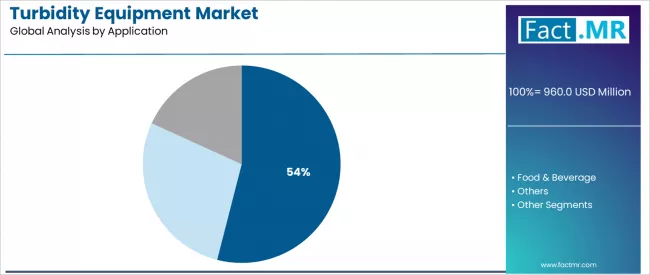
Water treatment applications dominate the turbidity equipment market with approximately 54% market share in 2025, reflecting the critical role of turbidity monitoring in supporting global water treatment operations and quality assurance processes worldwide. The water treatment segment's market leadership is reinforced by increasing regulatory compliance requirements, water quality standards, and rising requirements for precise contamination monitoring in municipal and industrial water treatment facilities across developed and emerging markets.
The food and beverage segment represents the second-largest application category, capturing 28% market share through specialized quality control requirements for beverage clarification, product consistency verification, and safety compliance applications. This segment benefits from growing demand for processed beverages that meet specific quality requirements, safety standards, and consumer expectations in competitive market environments.
The other applications segment accounts for 18% market share, serving laboratory research, environmental monitoring, and specialized industrial applications across various sectors. This segment focuses on research applications, environmental compliance, and specialized measurement requirements.
Key market dynamics supporting application growth include:
- Water treatment expansion driven by global infrastructure development and increasing demand for clean water requiring precise turbidity monitoring in emerging markets
- Food and beverage modernization trends require high-accuracy quality control systems for product differentiation and regulatory compliance
- Integration of automated monitoring technologies enabling real-time quality assurance and process optimization systems
- Growing emphasis on environmental compliance driving demand for intelligent, automated monitoring solutions without human error susceptibility
What are the Drivers, Restraints, and Key Trends of the Turbidity Equipment Market?
The market is driven by three concrete demand factors tied to water quality outcomes. First, regulatory compliance and water quality standards create increasing demand for precision turbidity monitoring, with environmental monitoring requirements expanding by 12-15% annually in major developed countries worldwide, requiring comprehensive turbidity measurement infrastructure. Second, industrial water treatment modernization and quality improvement initiatives drive increased adoption of turbidity monitoring systems, with many facilities implementing automated quality control processes for operational efficiency by 2030. Third, technological advancements in sensor technologies and digital interfaces enable more accurate and user-friendly turbidity solutions that reduce measurement errors while improving data collection capabilities and system integration features.
Market restraints include high equipment maintenance costs and calibration requirements that can deter smaller facilities from implementing comprehensive turbidity monitoring capabilities, particularly in developing regions where funding for advanced water monitoring equipment remains limited. Technical complexity and specialized operator training requirements pose another significant challenge, as turbidity systems demand regular calibration and ongoing maintenance optimization, potentially causing increased operational costs and implementation delays. Competitive pressure from alternative water quality measurement methods across different regions creates additional market challenges for turbidity equipment providers, demanding ongoing investment in technology innovation and cost optimization strategies.
Key trends indicate accelerated adoption in North American markets, particularly the United States and Canada, where regulatory enforcement and infrastructure modernization drive comprehensive turbidity monitoring system adoption. Technology integration trends toward IoT connectivity with cloud-based data management, predictive maintenance algorithms, and integrated quality management solutions enable proactive monitoring approaches that improve compliance and minimize operational downtime. The market thesis could face disruption if alternative water quality measurement technologies or significant changes in regulatory approaches reduce reliance on traditional turbidity monitoring systems.
Analysis of the Turbidity Equipment Market by Key Country
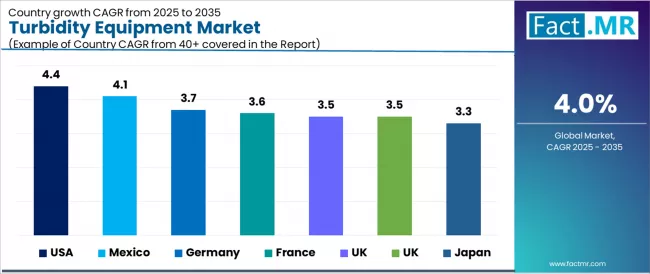
| Country | CAGR (2025-2035) |
|---|---|
| USA | 4.4% |
| Mexico | 4.1% |
| Germany | 3.7% |
| France | 3.6% |
| UK | 3.5% |
| South Korea | 3.5% |
| Japan | 3.3% |
The turbidity equipment market is gaining momentum worldwide, with the USA taking the lead thanks to stringent water quality regulations and advanced infrastructure modernization initiatives. Close behind, Mexico benefits from expanding water treatment activities and infrastructure development programs, positioning itself as a strategic growth hub in the Latin American region. Germany shows steady advancement, where integration of environmental monitoring technologies strengthens its role in the European water treatment supply chain. France and the UK are focusing on regulatory compliance and water quality improvement initiatives, signaling ambitions to capitalize on growing opportunities in European environmental monitoring markets. Meanwhile, South Korea stands out for its technology adoption in existing water treatment and environmental monitoring operations, and Japan continues to record consistent progress in advanced water quality monitoring modernization. Together, the USA and Mexico anchor the regional expansion story, while the rest build stability and diversity into the market's growth path.
The report covers an in-depth analysis of 40+ countries, the top-performing countries are highlighted below.
USA Leads Global Market Expansion
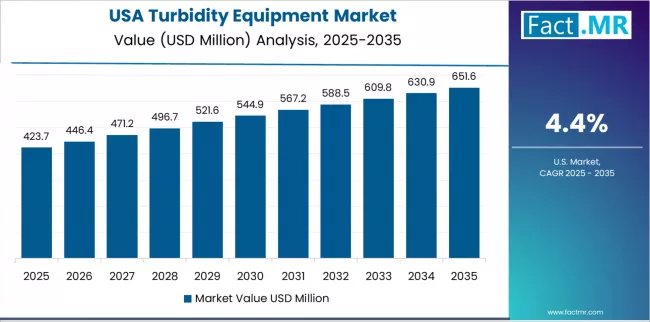
The USA demonstrates the strongest growth potential in the Turbidity Equipment Market with a CAGR of 4.4% through 2035. The country's leadership position stems from stringent EPA regulations, municipal water treatment expansion, and industrial compliance requirements driving the adoption of advanced turbidity monitoring solutions. Growth is concentrated in major metropolitan areas and industrial centers, including California, Texas, Florida, and the Northeast, where water treatment facilities and industrial operations implement advanced turbidity equipment for regulatory compliance and quality assurance. Distribution channels through specialized instrumentation distributors and direct sales expand coverage across municipal and industrial monitoring applications. The country's regulatory framework provides policy support for water quality monitoring modernization, including advanced turbidity measurement adoption.
Key market factors:
- Water treatment infrastructure expansion concentrated in urban areas and industrial zones with comprehensive quality monitoring programs
- Regulatory compliance requirements through EPA standards and state-level water quality initiatives
- Comprehensive instrumentation ecosystem, including established measurement technology providers with proven track records
- Technology integration featuring advanced sensor platforms, IoT connectivity systems, and data management technologies
Mexico Emerges as Strong Growth Market
In Mexico City, Guadalajara, Monterrey, and Tijuana, the adoption of turbidity monitoring solutions is expanding across water treatment facilities and industrial operations, driven by infrastructure modernization and environmental regulation enforcement. The market demonstrates strong growth momentum with a CAGR of 4.1% through 2035, linked to water infrastructure development and increasing focus on environmental compliance solutions. Mexican water utilities are implementing turbidity equipment and monitoring systems to enhance treatment effectiveness while meeting growing demand in expanding urban water treatment and industrial process monitoring sectors. The country's infrastructure investment programs and regulatory modernization create sustained demand for water monitoring solutions, while increasing emphasis on environmental compliance drives adoption of advanced measurement and control systems.
- Leading infrastructure expansion cities, including Mexico City, Guadalajara, Monterrey, and Puebla, are driving turbidity equipment adoption
- Water treatment development models enabling 30% faster monitoring system deployment timelines
- Infrastructure agreements accelerating installation with international turbidity equipment suppliers
- Environmental policy support through water quality modernization initiatives and regulatory compliance programs
Germany Maintains Environmental Technology Leadership
Germany's established environmental monitoring sector demonstrates sophisticated implementation of turbidity equipment solutions, with documented case studies showing 40% improvement in water quality compliance through advanced monitoring systems. The country's water treatment infrastructure in major cities, including Berlin, Munich, Hamburg, and Frankfurt, showcases integration of environmental technologies with existing water management systems, leveraging expertise in precision instrumentation and environmental engineering. German water utilities emphasize quality and environmental standards, creating demand for high-performance turbidity equipment that supports regulatory excellence initiatives and environmental protection requirements. The market maintains steady growth through focus on environmental technology integration and compliance excellence, with a CAGR of 3.7% through 2035.
Key development areas:
- Water treatment facilities and environmental monitoring centers leading turbidity equipment technology adoption with comprehensive modernization programs
- Environmental compliance services channels providing integrated solutions with 95% regulatory compliance rates
- Technology partnerships between turbidity equipment companies and German utilities expanding market reach
- Integration of environmental monitoring technologies and comprehensive water quality management systems
France Shows Strong Environmental Innovation
France's market expansion is driven by diverse water treatment demand, including municipal systems in Paris and industrial facilities in other major cities, and comprehensive environmental modernization across multiple regions. The country demonstrates solid growth potential with a CAGR of 3.6% through 2035, supported by environmental investment programs and water infrastructure development initiatives. French water utilities face implementation challenges related to aging infrastructure and regulatory compliance requirements, requiring strategic upgrade approaches and support from international suppliers. Growing environmental consciousness and regulatory enforcement create compelling business cases for turbidity equipment adoption, particularly in urban areas where water quality has a direct impact on public health and environmental compliance.
Market characteristics:
- Municipal water treatment segment showing consistent growth with 25% annual increase in turbidity equipment utilization
- Regional expansion trends focused on industrial areas and metropolitan water treatment centers
- Future projections indicate need for environmental monitoring infrastructure and water technology specialist programs
- Growing emphasis on water quality excellence and environmental compliance in water treatment operations
United Kingdom Demonstrates Environmental Innovation
The UK market shows strength in water quality innovation based on integration with smart water systems and environmental technologies for enhanced regulatory performance. The country shows steady potential with a CAGR of 3.5% through 2035, driven by the modernization of existing water infrastructure and the expansion of smart monitoring platforms in major areas, including London, Manchester, Birmingham, and Edinburgh. British water companies are adopting turbidity equipment for compliance optimization and operational efficiency, particularly in regions with established water treatment requirements and environmental standards demanding comprehensive monitoring upgrades. Technology deployment channels through established water utilities and environmental consultants expand coverage across municipal and industrial water treatment applications.
Leading market segments:
- Water infrastructure modernization projects in major metropolitan centers implementing comprehensive turbidity monitoring upgrades
- Utility partnerships with technology providers, achieving 90% compliance improvement rates
- Strategic collaborations between turbidity equipment suppliers and UK water companies expanding market presence
- Focus on environmental compliance and specialized water treatment requirements
South Korea Emphasizes Technology Integration
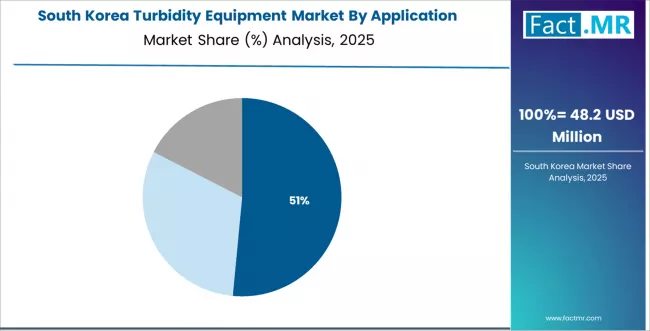
In Seoul, Busan, Incheon, and Daegu, water utilities are implementing comprehensive turbidity monitoring solutions to modernize existing water treatment infrastructure and improve compliance management, with documented case studies showing a 35% improvement in operational efficiency through advanced monitoring technologies. The market shows steady growth potential with a CAGR of 3.5% through 2035, linked to ongoing modernization of water treatment facilities, environmental consciousness expansion, and emerging smart water projects in major cities. Korean water companies are adopting turbidity equipment and monitoring platforms to enhance treatment effectiveness while maintaining environmental standards demanded by the competitive water utility and industrial sectors. The country's established technology infrastructure creates sustained demand for monitoring upgrade and modernization solutions that integrate with existing water management systems.
Market development factors:
- Water utilities and treatment facilities leading turbidity equipment modernization initiatives across urban areas
- Smart water modernization programs providing investment support for water treatment and monitoring infrastructure upgrades
- Strategic partnerships between Korean water companies and international turbidity equipment providers expanding technical capabilities
- Emphasis on operational efficiency and environmental standards compliance across water treatment applications
Japan Emphasizes Precision and Quality Excellence
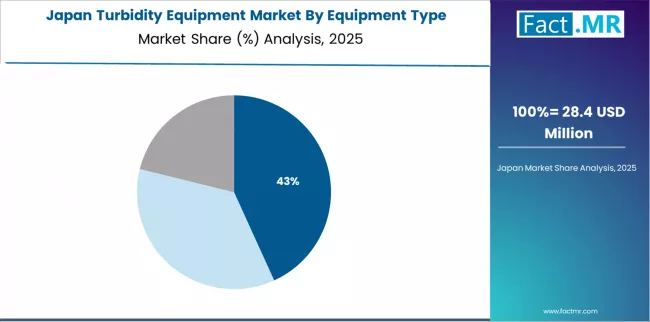
Japan's Turbidity Equipment Market demonstrates sophisticated implementation focused on precision monitoring and quality excellence optimization, with documented integration of advanced monitoring systems achieving 45% improvement in measurement accuracy across water treatment and environmental monitoring facilities. The country maintains steady growth momentum with a CAGR of 3.3% through 2035, driven by water utilities' emphasis on quality standards and precision monitoring methodologies that align with environmental excellence principles applied to water treatment operations. Major metropolitan areas, including Tokyo, Osaka, Nagoya, and Fukuoka, showcase advanced deployment of monitoring platforms where turbidity equipment systems integrate seamlessly with existing water management systems and comprehensive quality assurance programs.
Key market characteristics:
- Water treatment facilities and environmental monitoring centers driving precision turbidity equipment requirements with emphasis on quality and accuracy
- Quality management partnerships enabling 97% measurement reliability with comprehensive calibration programs
- Technology collaboration between Japanese companies and international turbidity equipment providers expanding market capabilities
- Emphasis on precision monitoring requirements and quality excellence methodologies
Europe Market Split by Country
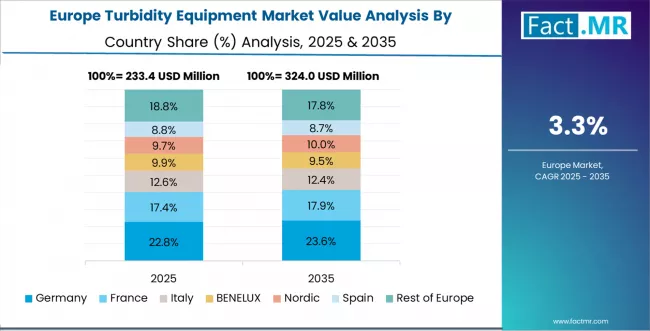
The turbidity equipment market in Europe is projected to grow from USD 285 million in 2025 to USD 420 million by 2035, registering a CAGR of 3.9% over the forecast period. Germany is expected to maintain its leadership position with a 28.5% market share in 2025, maintaining 28.2% by 2035, supported by its extensive water treatment infrastructure, advanced environmental regulations, and comprehensive industrial monitoring networks serving major European markets.
The United Kingdom follows with a 20.8% share in 2025, projected to reach 21.1% by 2035, driven by comprehensive water utility modernization programs in London, Manchester, and other industrial areas implementing advanced turbidity monitoring systems. France holds a 18.9% share in 2025, expected to maintain 18.7% by 2035 through ongoing development of water treatment facilities and environmental monitoring networks. Italy commands a 13.4% share, while Spain accounts for 10.6% in 2025. The Rest of Europe region is anticipated to gain momentum, expanding its collective share from 7.8% to 8.3% by 2035, attributed to increasing turbidity monitoring adoption in Nordic countries and emerging Eastern European water treatment facilities implementing environmental compliance programs.
Competitive Landscape of the Turbidity Equipment Market
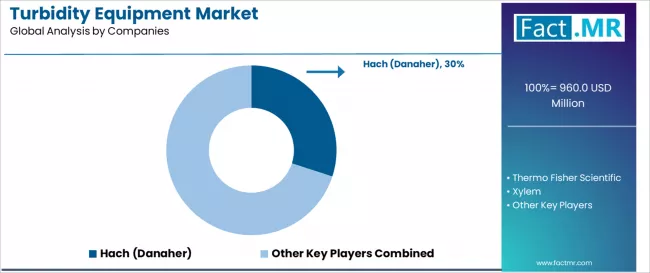
The turbidity equipment market features approximately 25-35 meaningful players with moderate concentration, where the top three companies control roughly 38-45% of global market share through established technology portfolios and extensive water treatment industry relationships. Competition centers on measurement accuracy, system reliability, and regulatory compliance capabilities rather than price competition alone.
Market leaders include Hach (Danaher), Thermo Fisher, and Xylem, which maintain competitive advantages through comprehensive turbidity monitoring solution portfolios, global service networks, and deep expertise in the water treatment and environmental monitoring sectors, creating high switching costs for customers. These companies leverage established regulatory relationships and ongoing service contracts to defend market positions while expanding into adjacent water quality and environmental monitoring applications.
Global Turbidity Equipment Market - Stakeholder Contribution Framework
Turbidity equipment solutions represent a critical water quality monitoring technology that enables water treatment facilities, laboratories, and industrial operations to enhance measurement accuracy and regulatory compliance without substantial manual testing requirements, typically providing 80-90% higher accuracy rates compared to traditional testing alternatives. With the market projected to grow from USD 960 million in 2025 to USD 1,420 million by 2035 at a 4% CAGR, these solutions offer compelling advantages - superior accuracy, enhanced compliance capabilities, and automated monitoring features - making them essential for water treatment (54% market share), food and beverage operations (28% share), and diverse industrial applications seeking reliable water quality monitoring solutions. Scaling market penetration and monitoring capabilities requires coordinated action across regulatory policy, industry standards, equipment manufacturers, technology providers, and research institutions.
How Governments Could Spur Local Production and Adoption?
- Water Quality Programs: Include turbidity monitoring capabilities in national water infrastructure development initiatives, providing targeted funding for water quality monitoring systems in underserved regions and supporting local technology companies through innovation grants and manufacturing incentives.
- Tax Policy & R&D Support: Implement accelerated depreciation schedules for turbidity equipment, provide tax incentives for companies investing in advanced monitoring technologies, and establish favorable research accounting standards that encourage intelligent water monitoring adoption over traditional testing approaches.
- Regulatory Framework Development: Create standardized turbidity measurement certification processes across water treatment and environmental monitoring applications, establish clear data accuracy frameworks for monitoring operation, and develop international harmonization protocols that facilitate cross-border water monitoring equipment trade.
- Skills Development & Training: Fund vocational programs for water quality technicians, environmental monitoring specialists, and laboratory professionals. Invest in technology transfer initiatives that bridge academic research with commercial turbidity equipment development and measurement optimization systems.
- Market Access & Competition: Establish procurement policies that favor high-accuracy monitoring solutions for government facility applications, support small and medium water treatment companies through preferential lending programs, and create regulatory environments that encourage innovation in water monitoring technologies.
How Industry Bodies Could Support Market Development?
- Measurement Standards & Certification: Define standardized accuracy metrics for turbidity equipment across water treatment, food and beverage, and laboratory applications, establish universal measurement and reliability protocols, and create certification programs for equipment performance that customers can rely on.
- Market Education & Best Practices: Lead messaging that demonstrates turbidity monitoring advantages, emphasizing improved accuracy, enhanced compliance capabilities, and superior data quality compared to traditional testing alternatives.
- Technology Integration Standards: Develop interoperability standards for turbidity monitoring systems, IoT compatibility guidelines, and data management platforms, ensuring seamless integration across different monitoring environments and regulatory requirements.
- Professional Development: Run certification programs for equipment operators, water quality specialists, and technical service teams on optimizing turbidity monitoring performance, calibration procedures, and compliance management in regulated environments.
How Manufacturers and Technology Players Could Strengthen the Ecosystem?
- Advanced Sensor Development: Develop next-generation turbidity monitoring systems with enhanced measurement capabilities, improved stability features, and application-specific monitoring features that enhance accuracy reliability while reducing calibration requirements.
- Intelligence Platforms: Provide comprehensive turbidity monitoring software that integrates measurement analytics, compliance reporting, predictive maintenance, and quality assurance, enabling facilities to maximize monitoring effectiveness and regulatory compliance.
- Service & Support Networks: Offer flexible support programs for water treatment facilities and laboratories, including calibration services, technical consultation options, and performance optimization pathways that keep monitoring systems current with regulatory demands.
- Research & Development Networks: Build comprehensive R&D capabilities, collaborative innovation programs, and application development systems that ensure turbidity equipment maintains high accuracy standards and consistent performance across diverse monitoring environments.
How Suppliers Could Navigate the Shift?
- Diversified Equipment Portfolios: Expand turbidity monitoring offerings across water treatment (54% market dominance), food and beverage (28% share), and other applications, with particular focus on portable equipment (42% technology share) and specialized solutions for diverse monitoring requirements.
- Geographic Market Development: Establish operations in high-growth markets like the USA (4.4% CAGR) and Mexico (4.1% CAGR), while strengthening presence in established markets like Germany (3.7% CAGR) and France (3.6% CAGR) through regional manufacturing capabilities and local partnerships.
- Technology-Enabled Services: Implement advanced monitoring support systems with real-time calibration tracking, automated maintenance alerts, and predictive accuracy features that differentiate service offerings and improve customer satisfaction and retention.
- Flexible Service Models: Develop standard, premium, and custom turbidity monitoring solutions that accommodate varying customer needs, from cost-effective portable testing to high-precision applications for demanding regulatory and research requirements.
How Investors and Financial Enablers Could Unlock Value?
- Water Technology Expansion Financing: Provide growth capital for established companies like Hach, Thermo Fisher, and Xylem to expand turbidity equipment production capacity and geographic coverage, particularly in emerging markets with growing water quality monitoring demands.
- Innovation Investment: Back startups developing advanced sensor technologies, IoT monitoring platforms, and intelligent calibration systems that enhance water monitoring industry efficiency and competitive positioning.
- Regional Market Development: Finance market entry and expansion strategies for turbidity equipment companies establishing operations in high-growth regions, supporting localization initiatives that reduce equipment costs while maintaining measurement accuracy standards.
- Consolidation & Scale Opportunities: Support strategic acquisitions and market consolidation that create economies of scale, improve monitoring capabilities, and enhance competitive positioning against fragmented regional equipment providers across multiple geographic markets.
Key Players in the Turbidity Equipment Market
- Hach (Danaher)
- Thermo Fisher Scientific
- Xylem
- Hanna Instruments
- Lovibond (Tintometer)
- LaMotte
- Merck Millipore
- Aqualabo
- HF Scientific
- KEM
Scope of the Report
| Item | Value |
|---|---|
| Quantitative Units | USD 960 million |
| Equipment Type | Portable, Benchtop, Online/Continuous |
| Application | Water Treatment, Food & Beverage, Others |
| Regions Covered | North America, Europe, Asia Pacific, Latin America, Middle East & Africa |
| Country Covered | USA, Germany, France, UK, Japan, South Korea, Mexico, and 40+ countries |
| Key Companies Profiled | Hach (Danaher), Thermo Fisher, Xylem, Hanna Instruments, Lovibond, LaMotte, Merck Millipore, Aqualabo, HF Scientific, KEM |
Turbidity Equipment Market by Segments
-
Equipment Type :
- Portable
- Benchtop
- Online/Continuous
-
Application :
- Water Treatment
- Food & Beverage
- Others
-
Region :
- North America
- United States
- Canada
- Mexico
- Europe
- Germany
- United Kingdom
- France
- Italy
- Spain
- Nordic
- BENELUX
- Rest of Europe
- Asia Pacific
- China
- Japan
- South Korea
- India
- Australia & New Zealand
- ASEAN
- Rest of Asia Pacific
- Latin America
- Brazil
- Chile
- Rest of Latin America
- Middle East & Africa
- Kingdom of Saudi Arabia
- Other GCC Countries
- Turkey
- South Africa
- Other African Union
- Rest of Middle East & Africa
- North America
Table of Content
- Executive Summary
- Global Market Outlook
- Demand to side Trends
- Supply to side Trends
- Technology Roadmap Analysis
- Analysis and Recommendations
- Market Overview
- Market Coverage / Taxonomy
- Market Definition / Scope / Limitations
- Market Background
- Market Dynamics
- Drivers
- Restraints
- Opportunity
- Trends
- Scenario Forecast
- Demand in Optimistic Scenario
- Demand in Likely Scenario
- Demand in Conservative Scenario
- Opportunity Map Analysis
- Product Life Cycle Analysis
- Supply Chain Analysis
- Investment Feasibility Matrix
- Value Chain Analysis
- PESTLE and Porter’s Analysis
- Regulatory Landscape
- Regional Parent Market Outlook
- Production and Consumption Statistics
- Import and Export Statistics
- Market Dynamics
- Global Market Analysis 2020 to 2024 and Forecast, 2025 to 2035
- Historical Market Size Value (USD Million) Analysis, 2020 to 2024
- Current and Future Market Size Value (USD Million) Projections, 2025 to 2035
- Y to o to Y Growth Trend Analysis
- Absolute $ Opportunity Analysis
- Global Market Pricing Analysis 2020 to 2024 and Forecast 2025 to 2035
- Global Market Analysis 2020 to 2024 and Forecast 2025 to 2035, By Equipment Type
- Introduction / Key Findings
- Historical Market Size Value (USD Million) Analysis By Equipment Type , 2020 to 2024
- Current and Future Market Size Value (USD Million) Analysis and Forecast By Equipment Type , 2025 to 2035
- Portable
- Benchtop
- Online/Continuous
- Y to o to Y Growth Trend Analysis By Equipment Type , 2020 to 2024
- Absolute $ Opportunity Analysis By Equipment Type , 2025 to 2035
- Global Market Analysis 2020 to 2024 and Forecast 2025 to 2035, By Application
- Introduction / Key Findings
- Historical Market Size Value (USD Million) Analysis By Application, 2020 to 2024
- Current and Future Market Size Value (USD Million) Analysis and Forecast By Application, 2025 to 2035
- Water Treatment
- Food & Beverage
- Others
- Y to o to Y Growth Trend Analysis By Application, 2020 to 2024
- Absolute $ Opportunity Analysis By Application, 2025 to 2035
- Global Market Analysis 2020 to 2024 and Forecast 2025 to 2035, By Region
- Introduction
- Historical Market Size Value (USD Million) Analysis By Region, 2020 to 2024
- Current Market Size Value (USD Million) Analysis and Forecast By Region, 2025 to 2035
- North America
- Latin America
- Western Europe
- Eastern Europe
- East Asia
- South Asia and Pacific
- Middle East & Africa
- Market Attractiveness Analysis By Region
- North America Market Analysis 2020 to 2024 and Forecast 2025 to 2035, By Country
- Historical Market Size Value (USD Million) Trend Analysis By Market Taxonomy, 2020 to 2024
- Market Size Value (USD Million) Forecast By Market Taxonomy, 2025 to 2035
- By Country
- USA
- Canada
- Mexico
- By Equipment Type
- By Application
- By Country
- Market Attractiveness Analysis
- By Country
- By Equipment Type
- By Application
- Key Takeaways
- Latin America Market Analysis 2020 to 2024 and Forecast 2025 to 2035, By Country
- Historical Market Size Value (USD Million) Trend Analysis By Market Taxonomy, 2020 to 2024
- Market Size Value (USD Million) Forecast By Market Taxonomy, 2025 to 2035
- By Country
- Brazil
- Chile
- Rest of Latin America
- By Equipment Type
- By Application
- By Country
- Market Attractiveness Analysis
- By Country
- By Equipment Type
- By Application
- Key Takeaways
- Western Europe Market Analysis 2020 to 2024 and Forecast 2025 to 2035, By Country
- Historical Market Size Value (USD Million) Trend Analysis By Market Taxonomy, 2020 to 2024
- Market Size Value (USD Million) Forecast By Market Taxonomy, 2025 to 2035
- By Country
- Germany
- UK
- Italy
- Spain
- France
- Nordic
- BENELUX
- Rest of Western Europe
- By Equipment Type
- By Application
- By Country
- Market Attractiveness Analysis
- By Country
- By Equipment Type
- By Application
- Key Takeaways
- Eastern Europe Market Analysis 2020 to 2024 and Forecast 2025 to 2035, By Country
- Historical Market Size Value (USD Million) Trend Analysis By Market Taxonomy, 2020 to 2024
- Market Size Value (USD Million) Forecast By Market Taxonomy, 2025 to 2035
- By Country
- Russia
- Poland
- Hungary
- Balkan & Baltic
- Rest of Eastern Europe
- By Equipment Type
- By Application
- By Country
- Market Attractiveness Analysis
- By Country
- By Equipment Type
- By Application
- Key Takeaways
- East Asia Market Analysis 2020 to 2024 and Forecast 2025 to 2035, By Country
- Historical Market Size Value (USD Million) Trend Analysis By Market Taxonomy, 2020 to 2024
- Market Size Value (USD Million) Forecast By Market Taxonomy, 2025 to 2035
- By Country
- China
- Japan
- South Korea
- By Equipment Type
- By Application
- By Country
- Market Attractiveness Analysis
- By Country
- By Equipment Type
- By Application
- Key Takeaways
- South Asia and Pacific Market Analysis 2020 to 2024 and Forecast 2025 to 2035, By Country
- Historical Market Size Value (USD Million) Trend Analysis By Market Taxonomy, 2020 to 2024
- Market Size Value (USD Million) Forecast By Market Taxonomy, 2025 to 2035
- By Country
- India
- ASEAN
- Australia & New Zealand
- Rest of South Asia and Pacific
- By Equipment Type
- By Application
- By Country
- Market Attractiveness Analysis
- By Country
- By Equipment Type
- By Application
- Key Takeaways
- Middle East & Africa Market Analysis 2020 to 2024 and Forecast 2025 to 2035, By Country
- Historical Market Size Value (USD Million) Trend Analysis By Market Taxonomy, 2020 to 2024
- Market Size Value (USD Million) Forecast By Market Taxonomy, 2025 to 2035
- By Country
- Kingdom of Saudi Arabia
- Other GCC Countries
- Turkiye
- South Africa
- Other African Union
- Rest of Middle East & Africa
- By Equipment Type
- By Application
- By Country
- Market Attractiveness Analysis
- By Country
- By Equipment Type
- By Application
- Key Takeaways
- Key Countries Market Analysis
- USA
- Pricing Analysis
- Market Share Analysis, 2024
- By Equipment Type
- By Application
- Canada
- Pricing Analysis
- Market Share Analysis, 2024
- By Equipment Type
- By Application
- Mexico
- Pricing Analysis
- Market Share Analysis, 2024
- By Equipment Type
- By Application
- Brazil
- Pricing Analysis
- Market Share Analysis, 2024
- By Equipment Type
- By Application
- Chile
- Pricing Analysis
- Market Share Analysis, 2024
- By Equipment Type
- By Application
- Germany
- Pricing Analysis
- Market Share Analysis, 2024
- By Equipment Type
- By Application
- UK
- Pricing Analysis
- Market Share Analysis, 2024
- By Equipment Type
- By Application
- Italy
- Pricing Analysis
- Market Share Analysis, 2024
- By Equipment Type
- By Application
- Spain
- Pricing Analysis
- Market Share Analysis, 2024
- By Equipment Type
- By Application
- France
- Pricing Analysis
- Market Share Analysis, 2024
- By Equipment Type
- By Application
- India
- Pricing Analysis
- Market Share Analysis, 2024
- By Equipment Type
- By Application
- ASEAN
- Pricing Analysis
- Market Share Analysis, 2024
- By Equipment Type
- By Application
- Australia & New Zealand
- Pricing Analysis
- Market Share Analysis, 2024
- By Equipment Type
- By Application
- China
- Pricing Analysis
- Market Share Analysis, 2024
- By Equipment Type
- By Application
- Japan
- Pricing Analysis
- Market Share Analysis, 2024
- By Equipment Type
- By Application
- South Korea
- Pricing Analysis
- Market Share Analysis, 2024
- By Equipment Type
- By Application
- Russia
- Pricing Analysis
- Market Share Analysis, 2024
- By Equipment Type
- By Application
- Poland
- Pricing Analysis
- Market Share Analysis, 2024
- By Equipment Type
- By Application
- Hungary
- Pricing Analysis
- Market Share Analysis, 2024
- By Equipment Type
- By Application
- Kingdom of Saudi Arabia
- Pricing Analysis
- Market Share Analysis, 2024
- By Equipment Type
- By Application
- Turkiye
- Pricing Analysis
- Market Share Analysis, 2024
- By Equipment Type
- By Application
- South Africa
- Pricing Analysis
- Market Share Analysis, 2024
- By Equipment Type
- By Application
- USA
- Market Structure Analysis
- Competition Dashboard
- Competition Benchmarking
- Market Share Analysis of Top Players
- By Regional
- By Equipment Type
- By Application
- Competition Analysis
- Competition Deep Dive
- Hach (Danaher)
- Overview
- Product Portfolio
- Profitability by Market Segments (Product/Age /Sales Channel/Region)
- Sales Footprint
- Strategy Overview
- Marketing Strategy
- Product Strategy
- Channel Strategy
- Thermo Fisher Scientific
- Xylem
- Hanna Instruments
- Lovibond (Tintometer)
- LaMotte
- Merck Millipore
- Aqualabo
- HF Scientific
- KEM
- Hach (Danaher)
- Competition Deep Dive
- Assumptions & Acronyms Used
- Research Methodology
List Of Table
- Table 1: Global Market Value (USD Million) Forecast by Region, 2020 to 2035
- Table 2: Global Market Value (USD Million) Forecast by Equipment Type , 2020 to 2035
- Table 3: Global Market Value (USD Million) Forecast by Application, 2020 to 2035
- Table 4: North America Market Value (USD Million) Forecast by Country, 2020 to 2035
- Table 5: North America Market Value (USD Million) Forecast by Equipment Type , 2020 to 2035
- Table 6: North America Market Value (USD Million) Forecast by Application, 2020 to 2035
- Table 7: Latin America Market Value (USD Million) Forecast by Country, 2020 to 2035
- Table 8: Latin America Market Value (USD Million) Forecast by Equipment Type , 2020 to 2035
- Table 9: Latin America Market Value (USD Million) Forecast by Application, 2020 to 2035
- Table 10: Western Europe Market Value (USD Million) Forecast by Country, 2020 to 2035
- Table 11: Western Europe Market Value (USD Million) Forecast by Equipment Type , 2020 to 2035
- Table 12: Western Europe Market Value (USD Million) Forecast by Application, 2020 to 2035
- Table 13: Eastern Europe Market Value (USD Million) Forecast by Country, 2020 to 2035
- Table 14: Eastern Europe Market Value (USD Million) Forecast by Equipment Type , 2020 to 2035
- Table 15: Eastern Europe Market Value (USD Million) Forecast by Application, 2020 to 2035
- Table 16: East Asia Market Value (USD Million) Forecast by Country, 2020 to 2035
- Table 17: East Asia Market Value (USD Million) Forecast by Equipment Type , 2020 to 2035
- Table 18: East Asia Market Value (USD Million) Forecast by Application, 2020 to 2035
- Table 19: South Asia and Pacific Market Value (USD Million) Forecast by Country, 2020 to 2035
- Table 20: South Asia and Pacific Market Value (USD Million) Forecast by Equipment Type , 2020 to 2035
- Table 21: South Asia and Pacific Market Value (USD Million) Forecast by Application, 2020 to 2035
- Table 22: Middle East & Africa Market Value (USD Million) Forecast by Country, 2020 to 2035
- Table 23: Middle East & Africa Market Value (USD Million) Forecast by Equipment Type , 2020 to 2035
- Table 24: Middle East & Africa Market Value (USD Million) Forecast by Application, 2020 to 2035
List Of Figures
- Figure 1: Global Market Pricing Analysis
- Figure 2: Global Market Value (USD Million) Forecast 2020-2035
- Figure 3: Global Market Value Share and BPS Analysis by Equipment Type , 2025 and 2035
- Figure 4: Global Market Y to o to Y Growth Comparison by Equipment Type , 2025-2035
- Figure 5: Global Market Attractiveness Analysis by Equipment Type
- Figure 6: Global Market Value Share and BPS Analysis by Application, 2025 and 2035
- Figure 7: Global Market Y to o to Y Growth Comparison by Application, 2025-2035
- Figure 8: Global Market Attractiveness Analysis by Application
- Figure 9: Global Market Value (USD Million) Share and BPS Analysis by Region, 2025 and 2035
- Figure 10: Global Market Y to o to Y Growth Comparison by Region, 2025-2035
- Figure 11: Global Market Attractiveness Analysis by Region
- Figure 12: North America Market Incremental Dollar Opportunity, 2025-2035
- Figure 13: Latin America Market Incremental Dollar Opportunity, 2025-2035
- Figure 14: Western Europe Market Incremental Dollar Opportunity, 2025-2035
- Figure 15: Eastern Europe Market Incremental Dollar Opportunity, 2025-2035
- Figure 16: East Asia Market Incremental Dollar Opportunity, 2025-2035
- Figure 17: South Asia and Pacific Market Incremental Dollar Opportunity, 2025-2035
- Figure 18: Middle East & Africa Market Incremental Dollar Opportunity, 2025-2035
- Figure 19: North America Market Value Share and BPS Analysis by Country, 2025 and 2035
- Figure 20: North America Market Value Share and BPS Analysis by Equipment Type , 2025 and 2035
- Figure 21: North America Market Y to o to Y Growth Comparison by Equipment Type , 2025-2035
- Figure 22: North America Market Attractiveness Analysis by Equipment Type
- Figure 23: North America Market Value Share and BPS Analysis by Application, 2025 and 2035
- Figure 24: North America Market Y to o to Y Growth Comparison by Application, 2025-2035
- Figure 25: North America Market Attractiveness Analysis by Application
- Figure 26: Latin America Market Value Share and BPS Analysis by Country, 2025 and 2035
- Figure 27: Latin America Market Value Share and BPS Analysis by Equipment Type , 2025 and 2035
- Figure 28: Latin America Market Y to o to Y Growth Comparison by Equipment Type , 2025-2035
- Figure 29: Latin America Market Attractiveness Analysis by Equipment Type
- Figure 30: Latin America Market Value Share and BPS Analysis by Application, 2025 and 2035
- Figure 31: Latin America Market Y to o to Y Growth Comparison by Application, 2025-2035
- Figure 32: Latin America Market Attractiveness Analysis by Application
- Figure 33: Western Europe Market Value Share and BPS Analysis by Country, 2025 and 2035
- Figure 34: Western Europe Market Value Share and BPS Analysis by Equipment Type , 2025 and 2035
- Figure 35: Western Europe Market Y to o to Y Growth Comparison by Equipment Type , 2025-2035
- Figure 36: Western Europe Market Attractiveness Analysis by Equipment Type
- Figure 37: Western Europe Market Value Share and BPS Analysis by Application, 2025 and 2035
- Figure 38: Western Europe Market Y to o to Y Growth Comparison by Application, 2025-2035
- Figure 39: Western Europe Market Attractiveness Analysis by Application
- Figure 40: Eastern Europe Market Value Share and BPS Analysis by Country, 2025 and 2035
- Figure 41: Eastern Europe Market Value Share and BPS Analysis by Equipment Type , 2025 and 2035
- Figure 42: Eastern Europe Market Y to o to Y Growth Comparison by Equipment Type , 2025-2035
- Figure 43: Eastern Europe Market Attractiveness Analysis by Equipment Type
- Figure 44: Eastern Europe Market Value Share and BPS Analysis by Application, 2025 and 2035
- Figure 45: Eastern Europe Market Y to o to Y Growth Comparison by Application, 2025-2035
- Figure 46: Eastern Europe Market Attractiveness Analysis by Application
- Figure 47: East Asia Market Value Share and BPS Analysis by Country, 2025 and 2035
- Figure 48: East Asia Market Value Share and BPS Analysis by Equipment Type , 2025 and 2035
- Figure 49: East Asia Market Y to o to Y Growth Comparison by Equipment Type , 2025-2035
- Figure 50: East Asia Market Attractiveness Analysis by Equipment Type
- Figure 51: East Asia Market Value Share and BPS Analysis by Application, 2025 and 2035
- Figure 52: East Asia Market Y to o to Y Growth Comparison by Application, 2025-2035
- Figure 53: East Asia Market Attractiveness Analysis by Application
- Figure 54: South Asia and Pacific Market Value Share and BPS Analysis by Country, 2025 and 2035
- Figure 55: South Asia and Pacific Market Value Share and BPS Analysis by Equipment Type , 2025 and 2035
- Figure 56: South Asia and Pacific Market Y to o to Y Growth Comparison by Equipment Type , 2025-2035
- Figure 57: South Asia and Pacific Market Attractiveness Analysis by Equipment Type
- Figure 58: South Asia and Pacific Market Value Share and BPS Analysis by Application, 2025 and 2035
- Figure 59: South Asia and Pacific Market Y to o to Y Growth Comparison by Application, 2025-2035
- Figure 60: South Asia and Pacific Market Attractiveness Analysis by Application
- Figure 61: Middle East & Africa Market Value Share and BPS Analysis by Country, 2025 and 2035
- Figure 62: Middle East & Africa Market Value Share and BPS Analysis by Equipment Type , 2025 and 2035
- Figure 63: Middle East & Africa Market Y to o to Y Growth Comparison by Equipment Type , 2025-2035
- Figure 64: Middle East & Africa Market Attractiveness Analysis by Equipment Type
- Figure 65: Middle East & Africa Market Value Share and BPS Analysis by Application, 2025 and 2035
- Figure 66: Middle East & Africa Market Y to o to Y Growth Comparison by Application, 2025-2035
- Figure 67: Middle East & Africa Market Attractiveness Analysis by Application
- Figure 68: Global Market - Tier Structure Analysis
- Figure 69: Global Market - Company Share Analysis
- FAQs -
How big is the turbidity equipment market in 2025?
The global turbidity equipment market is estimated to be valued at USD 960.0 million in 2025.
What will be the size of turbidity equipment market in 2035?
The market size for the turbidity equipment market is projected to reach USD 1,421.0 million by 2035.
How much will be the turbidity equipment market growth between 2025 and 2035?
The turbidity equipment market is expected to grow at a 4.0% CAGR between 2025 and 2035.
What are the key product types in the turbidity equipment market?
The key product types in turbidity equipment market are portable, benchtop and online/continuous.
Which application segment to contribute significant share in the turbidity equipment market in 2025?
In terms of application, water treatment segment to command 54.0% share in the turbidity equipment market in 2025.